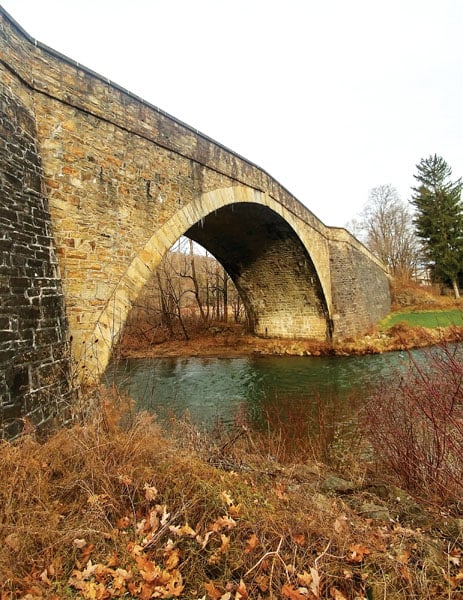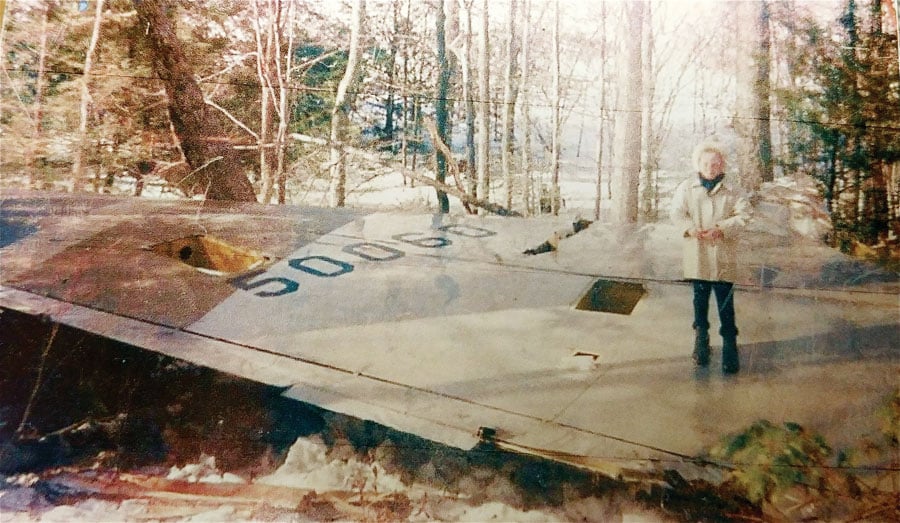It was approximately 1:40 am on January 13, 1964, as the small town of Grantsville, Maryland hunkered down through a winter blizzard, that a B-52 armed with two thermonuclear bombs slammed into nearby Big Savage Mountain.
The plane was one of at least a dozen U.S. bombers in the air at all times that flew directly toward Russian air targets before breaking off their routes as part of a Cold War initiative dubbed Operation Chrome Dome. The rationale for Chrome Dome was a simple, grim calculus. In the event of a first-strike nuclear attack by Russia, U.S. bombers would already be in a position to deliver a retaliatory strike as part of an unfolding Armageddon.
The plane that hit Big Savage in the mountainous panhandle of western Maryland was returning from Westover Air Force Base in Massachusetts to its home at Georgia’s Turner Air Force Base where it could resume its flying missions.
The flight was given code name Buzz One Four, and its combined nuclear payload was 1,000 times more destructive than the bomb dropped on Hiroshima during WW II. Due to a known structural flaw, the vertical rear stabilizer snapped off the 156-foot-long bomber in the heavy turbulence accompanying the winter storm and sent it into an uncontrollable spin into the still largely unpopulated mountain region.
Bill Richmond, 79, of nearby Lonaconing, Md., remembers hearing what was likely the ditching airplane approaching the mountain. “I was with our baby, about 1:30 or 1:45 in the morning. We had a newborn who was born that December and I was up with him. I heard the plane. It was unusual; it was a real cold night and snowing heavily, not good flying weather,” said Richmond. “And then by the next day, we knew about the crash.”
Of the five-member crew, four ejected into a raging winter storm and were probably out of the bomber by the time Richmond recalls hearing it. Of the four, only two survived the sub-zero wind chill and three-foot drifting snows that awaited them when they parachuted into the jutting hills of the countryside.
Major Thomas W. McCormick piloted the plane and was the first to emerge safely after navigating his way some two miles through deep snow to a still-standing farmhouse on State Route 40, just east of Grantsville.
Co-pilot Captain Parker “Mack” Peedin, the only other survivor, was rescued several miles to the south of McCormick. Peedin took elements of his parachute and erected a makeshift tent. The tent had as its base an inverted life raft that provided life-saving air insulation between him and the snow.
The remainder of the crew perished. Major Robert J. Townley, the radar bombardier, died upon impact at the crash site. His death, while tragic, proved mercifully quicker than those of Major Robert Payne and Sergeant Melvin Wooten, as they landed in the snow-blinded folds of the Appalachians that pass vertically through the state’s panhandle.

Gerry Beachy of the Grantsville Community Museum, and a former mayor of the town, was 16 at the time of the crash and recalls the ensuing days vividly.
Dozens of citizens that included Beachy were assembled to help locate the downed fliers or their bodies. “We formed a line on the hillside along with the military. The snow was still blanketing the trees,” said Beachy, 64. “We walked along, and if we saw something under the snow—a large rock or something—we’d check it out and make sure it wasn’t a flier.”
“No one found anything that day. Wooten was over in Salisbury, and that’s who we were really looking for,” said Beachy. “McCormick came out first; Peedin came out the second day. At the crash site they found Townley,” said Beachy.
Wooten was the first to evacuate the plane, based on his northernmost landing point. He set down in Salisbury, Pennsylvania, several miles north of Grantsville up Route 216, a small town along the banks of the Casselman River. Although he escaped the crashing bomber, Wooten was severely injured in the process, shattering his left thigh and gashing his head, chest, and hands. He was found on the embankment of the river, partially frozen by its waters.
In December I walked along the Casselman in Salisbury. Fifty years removed from the incident, it remains a decidedly small place, but as I strode along its muddy banks to the spot where Wooten perished, houses that predated 1964 are achingly near at hand.
Viewing Wooten’s small memorial, you’re also looking a half-mile east to the main of Salisbury. It’s not difficult to picture the injured sergeant seeing lights from the same, but tragically unable to know that the partially frozen river was between him and the town.
Separate search efforts were underway that ultimately led to Payne. His parachute was spotted late on Monday and a small group of (by Beachy’s estimate) seven civilians assembled and dispatched into the thick forest in its direction.
Payne had parachuted into the depths of New Germany State Park. “As he landed, part of his chute got stuck in a tree, and he cut himself free,” said Beachy. Payne was tragically unprepared for the elements, having dressed in his summer aviator’s suit prior to the hastily scheduled flight.
“He walked about a half-mile to a grove of trees—perhaps looking for dry wood for a fire.”
Payne managed to cross the stream several times while remaining dry. Ultimately his body succumbed to the extreme temperatures. He was found by searchers in a crouched position next to Poplar Lick Run, frozen in place. Temperature estimates range from 10 above to 10 below zero at the time of the crash.
“If he’d gone 100 yards in another direction, he would have found a road, and he would have found a house. He might have survived,” said Beachy.
As I walked through the New Germany State Park to where Payne was recovered, the forest is thick with river birch, black gum, red maple, and rhododendron. Even without standing snow, harrowing winds and nightfall, I’m able to—on a basic level—see the difficulty of traversing this area even in ideal conditions.
Several of the search party that recovered Payne’s body fell into Poplar Lick in the effort. “They made a makeshift stretcher out of two saplings and a blanket and put him on it. They tried to keep him on the blanket,” said Beachy. “There were no roads or anything there—they just had to walk down through the woods, and they knew to walk toward Savage River Road.”
Payne’s body kept falling off the stretcher, so they would stop frequently to place him back on and to warm themselves. “They almost died—if you consider the temperatures and conditions walking through the woods.”
The military attempted to work their way back to the rescue group with road-clearing equipment, but due to the depth of the snow couldn’t get far from an impromptu base at Savage River Road.
The citizens worked through it all, despite uncertainties about a nuclear payload that, if detonated, would have removed the entire region from the map in a cataclysmic nightmare. One night during the week following the crash, the Lutheran Church Women of St. John’s served 1,500 dinners of roasted chicken, baked ham, mashed potatoes, gravy and corn to rescue workers and the military. They repeated the effort the next night.
The Air Force assured the civilians that there was no threat of detonation from the bombs. In the throes of a Cold War, however, military assurances could sometimes hew more closely to a manageable narrative than the untoward realities of a given situation.
The 28th Ordnance Team was scrambled from Maryland’s Fort Meade to secure the bombs, and made its way west as the elements permitted. Ultimately, it was area residents who removed the two bombs directly from the crash site. Ray Giconi, who ran the local quarry, assembled a group of citizens and hoisted the nuclear payload onto two dump trucks that he owned.
Showing the sensibilities innate to the residents of a region where nature still holds dominant sway, he stopped by a nearby state boy’s camp and lined the trucks with mattresses for good measure.







